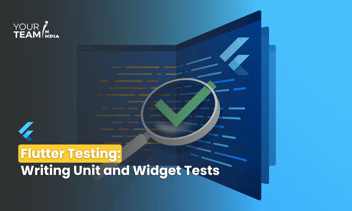This blog post explores the powerful combination of Flutter and Cloud Functions for building Progressive Web Apps (PWAs). It covers the benefits of PWAs, the advantages of Flutter for web development, and the steps involved in integrating Cloud Functions with Flutter.
Introduction
What is Flutter?
Flutter is an open-source UI toolkit created by Google, designed for building high-performance, natively compiled applications across multiple platforms, including mobile, web, and desktop, from a single codebase. It is built on the Dart programming language and provides a rich set of pre-designed widgets and tools for developing visually appealing and highly interactive applications.
Key Features of Flutter:
- Unified Codebase: Write once, deploy everywhere—mobile, web, and desktop.
- Rich Widget Library: A comprehensive set of widgets to create responsive and attractive UIs.
- Hot Reload: Enables developers to see changes instantly without restarting the app.
- High Performance: Native compilation ensures fast and efficient performance.
What is a Progressive Web App (PWA)?
A Progressive Web App (PWA) is a type of web application designed to deliver a native app-like experience using modern web capabilities. PWAs aim to provide a reliable, fast, and engaging user experience across various devices and network conditions.
Characteristics of PWAs:
- Progressive: Works for every user, regardless of browser choice, with progressive enhancement.
- Responsive: Fits any device, from mobile phones to desktops.
- Offline Capabilities: Works offline or with poor network conditions, thanks to service workers.
- App-like: Feels like an app with smooth interactions and navigation.
- Fresh: Always up-to-date with the latest content, using caching and background sync.
- Secure: Delivered via HTTPS to ensure data security.
- Installable: Can be added to the home screen for easy access.
Building PWAs with Flutter
Overview: Flutter supports web development and enables developers to build Progressive Web Apps (PWAs) using its existing toolkit. With Flutter for Web, you can leverage the same codebase used for mobile apps to create high-performance web applications with PWA capabilities.
Steps to Build a PWA with Flutter
1. Set Up Your Flutter Environment for Web Development
Ensure that you have Flutter installed and set up for web development. You need to have Flutter SDK version 2.0 or later. To enable web support, run:
| flutter channel stable flutter upgrade flutter config --enable-web |
Verify that web support is enabled by running:
| flutter devices |
You should see Chrome and/or Web Server listed as available devices.
2. Create a Flutter Project
Create a new Flutter project or navigate to an existing one:
| flutter create my_pwa cd my_pwa |
3. Build Your Application
Develop your application using Flutter's widgets and tools. You can use existing Flutter widgets to build responsive layouts that adapt to various screen sizes. To effectively build PWAs with Flutter, it's essential to have a skilled team of Flutter developers. Hire Flutter Developers who possess expertise in Flutter's framework and understand the nuances of PWA development.
Here’s an example of a simple Flutter widget for a PWA:
| import 'package:flutter/material.dart'; void main() { runApp(MyApp()); } class MyApp extends StatelessWidget { @override Widget build(BuildContext context) { return MaterialApp( title: 'My PWA', theme: ThemeData( primarySwatch: Colors.blue, ), home: MyHomePage(), ); } } class MyHomePage extends StatelessWidget { @override Widget build(BuildContext context) { return Scaffold( appBar: AppBar( title: Text('Welcome to My PWA'), ), body: Center( child: Text( 'Hello, Flutter Web!', style: TextStyle(fontSize: 24), ), ), ); } } |
4. Configure PWA Settings
Flutter provides a default configuration for PWAs, but you can customize it by editing the web/ directory in your project:
- web/index.html: Customize the HTML structure, including meta tags and link tags for the PWA.
- web/manifest.json: Modify the web manifest to define app icons, theme colors, and other PWA-specific settings.
- web/service_worker.js: Customize the service worker to control caching and offline functionality.
Here is an example of a manifest.json configuration:
| { "name": "My PWA", "short_name": "PWA", "description": "A Flutter-based Progressive Web App", "icons": [ { "src": "icons/icon-192x192.png", "sizes": "192x192", "type": "image/png" }, { "src": "icons/icon-512x512.png", "sizes": "512x512", "type": "image/png" } ], "start_url": "/", "display": "standalone", "background_color": "#ffffff", "theme_color": "#2196f3" } |
5. Test Your PWA
To test your PWA locally, run:
| flutter run -d chrome |
To build your project for production, use:
| flutter build web |
The generated files in the build/web directory can be deployed to any web server.
6. Deploy Your PWA
Deploy your PWA to a web server or hosting platform of your choice, such as Firebase Hosting, Netlify, or GitHub Pages.
Benefits of Using Flutter for PWAs
- Unified Codebase: Leverage the same codebase for mobile and web applications, reducing development time and effort.
- Rich UI Capabilities: Utilize Flutter’s comprehensive widget library to create engaging and interactive user interfaces.
- Performance: Achieve high performance with Flutter’s compiled code and optimized rendering engine.
- Development Efficiency: Benefit from Flutter’s hot reload and other development tools to streamline the build process.
Conclusion
Flutter enables developers to build high-quality Progressive Web Apps (PWAs) with a single codebase. By utilizing Flutter’s extensive toolkit and capabilities, you can create responsive, fast, and engaging web applications that offer a native app-like experience. The combination of Flutter’s rich UI features and the advantages of PWAs, such as offline capabilities and installation on user devices, provides a powerful solution for modern web development.







